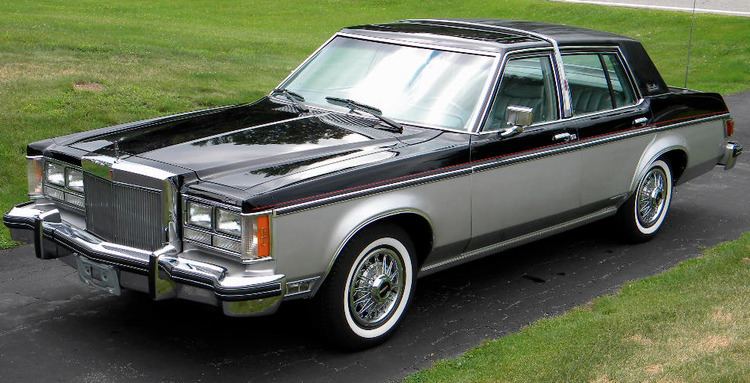Production 1977–1980 Body style 4-door sedan | ||
 | ||
Assembly United States: Wayne, Michigan (Wayne Stamping & Assembly)United States: Mahwah, New Jersey (Mahwah Assembly) | ||
The Lincoln Versailles is a compact luxury car that was marketed by the Lincoln division of Ford Motor Company. A rebadged variant of the Mercury Monarch and Ford Granada, the Lincoln Versailles was sold from the 1977 to the 1980 model years.
Contents
The smallest Lincoln produced until the introduction of the Lincoln LS in 2000, the Lincoln Versailles was developed largely as a response to the Cadillac Seville and to European luxury sedans. With only 50,156 produced over its entire production run, sales of the Versailles fell well under Ford Motor Company projections.
The Lincoln Versailles nameplate derives eponymously from the noted 17th-century palace outside Paris.
Background
During the mid-1970s, the Lincoln division of Ford sought to expand its model range for multiple reasons. In comparison to the four distinct luxury model lines offered by Cadillac and the three offered by Chrysler (including Imperial), Lincoln offered only two distinct model lines in 1975. While sales of large luxury cars went on to rebound after the 1973 oil crisis, its impact lead to the rise of imported cars. As Honda and Toyota began to gain market share in the economy-car segment, the luxury car segment gained competition from smaller vehicles, as well. While competing in price with Cadillac, Imperial, and Lincoln, the West German BMW 3.0Si and Mercedes-Benz 350SE/450SE offered American luxury-car buyers a far different vehicle than produced by American manufacturers.
In May 1975, General Motors introduced the Cadillac Seville as an all-new 1976 model in response to both the fuel crisis and import models like the Mercedes-Benz S-Class. While the smallest Cadillac, the Seville was also priced as its most expensive model. Although using the chassis and mechanical underpinnings of the Chevrolet Nova to save on engineering and development costs, the Seville was given its own exterior; no body panels were shared between the vehicles. Two years after the introduction of the Seville, Lincoln brought out its all-new Versailles. Despite being the smallest Lincoln in the lineup for 1977, the Versailles carried the highest base price at $11,500.
The first Lincoln manufactured outside of Wixom Assembly since 1957, the Versailles was produced alongside the Mercury Monarch and Ford Granada. The model was notable for being the first production vehicle to be sold with clearcoat paint and halogen headlights in North America.
Exterior
With a smaller budget than General Motors in its development of the Seville, relatively few changes were made to differentiate the Lincoln Versailles from a Mercury Monarch sold in the same showroom. In the front, the body was restyled slightly to resemble the Continental Mark V. For the first time since 1969, a Lincoln again had exposed headlights; the Versailles marked the debut of rectangular headlamps on a Lincoln. In the rear, the influence of the Mark V also showed, as a "Continental spare" was grafted onto the trunklid (relettered LINCOLN instead of CONTINENTAL).
For the 1979 model year, the rear roofline was redesigned with notchback styling exclusive for the Versailles. Consisting of a rear fiberglass cap, the new roofline required the use of new quarter windows and included a standard vinyl landau roof.
Interior
The Versailles wore similar trim to its Mercury Monarch counterpart and largely took over the role of the Grand Monarch Ghia, and it featured extensive standard equipment and added features seen in the Continental, such as leather-trimmed seats and steering wheel, digital LCD clock, power steering, dual map lights, lighted passenger vanity mirror, reclining power bucket seats with rear-seat map pockets, and plush carpeting with soundproofing.
Chassis
The Versailles shares its wheelbase with the Ford Granada/Mercury Monarch and the four-door Ford Maverick/Mercury Comet.
According to Lincoln advertising, a quality-control regimen was used at the factory. According to the marketing, final assembly included dynamometer testing of the engine/transmission, a water spray test to pinpoint body leaks, and a simulated road test. The Versailles featured "matched and balanced" driveline elements, low-friction lower ball joints, double isolated shocks, reinforced chassis areas, sound insulation, and balanced forged 14" aluminum wheels with Michelin whitewall X-radials. Bodywork received the first clearcoat paint on a regular production car.”
The Versailles shared its powertrain with the Monarch upon which it was based, with a V8 engine as a sole choice. Initially, the Versailles was powered by the 351 cubic-inch V8, phased out in favor of the 302 cubic-inch V8. The three-speed C4 automatic transmission was the only transmission available. The rear differential used in the Versailles was Ford 9-inch with rear disc brakes, replacing the drums on the Granada and the Monarch.
Sales
In comparison to the Cadillac Seville, the Lincoln Versailles fared poorly, outsold by the Cadillac by a three to one margin in its 1977 debut year. Following its update for the 1979 model year, sales of the Versailles would more than double, though remaining far behind its Cadillac counterpart.
In its entire production run, Lincoln would sell 50,156 examples of the Versailles. By comparison, Cadillac would outsell that total in both 1978 and 1979, the last two years of the first-generation Seville.
